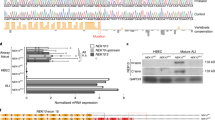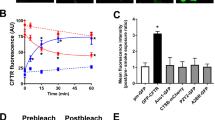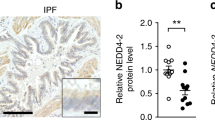Abstract
Mutations in the cystic fibrosis transmembrane conductance regulator (CFTR) gene result in defective epithelial cAMP-dependent Cl− secretion and increased airway Na+ absorption. The mechanistic links between these altered ion transport processes and the pathogenesis of cystic fibrosis lung disease, however, are unclear. To test the hypothesis that accelerated Na+ transport alone can produce cystic fibrosis-like lung disease, we generated mice with airway-specific overexpression of epithelial Na+ channels (ENaC). Here we show that increased airway Na+ absorption in vivo caused airway surface liquid (ASL) volume depletion, increased mucus concentration, delayed mucus transport and mucus adhesion to airway surfaces. Defective mucus transport caused a severe spontaneous lung disease sharing features with cystic fibrosis, including mucus obstruction, goblet cell metaplasia, neutrophilic inflammation and poor bacterial clearance. We conclude that increasing airway Na+ absorption initiates cystic fibrosis-like lung disease and produces a model for the study of the pathogenesis and therapy of this disease.
This is a preview of subscription content, access via your institution
Access options
Subscribe to this journal
Receive 12 print issues and online access
$209.00 per year
only $17.42 per issue
Buy this article
- Purchase on Springer Link
- Instant access to full article PDF
Prices may be subject to local taxes which are calculated during checkout





Similar content being viewed by others
References
Kerem, B. et al. Identification of the cystic fibrosis gene: genetic analysis. Science 245, 1073–1080 (1989).
Welsh, M.J., Ramsey, B.W., Accurso, F. & Cutting, G.R. Cystic fibrosis. in The Metabolic & Molecular Bases of Inherited Disease (eds. Scriver, C.R., Beaudet, A.L., Sly, W.S. & Valle, D.) 5121–5188 (McGraw-Hill, New York, 2001).
Anderson, M.P. et al. Demonstration that CFTR is a chloride channel by alteration of its anion selectivity. Science 253, 202–205 (1991).
Smith, J.J., Travis, S.M., Greenberg, E.P. & Welsh, M.J. Cystic fibrosis airway epithelia fail to kill bacteria because of abnormal airway surface fluid. Cell 85, 229–236 (1996).
Zabner, J., Smith, J.J., Karp, P.H., Widdicombe, J.H. & Welsh, M.J. Loss of CFTR chloride channels alters salt absorption by cystic fibrosis airway epithelia in vitro. Mol. Cell 2, 397–403 (1998).
Canessa, C.M. et al. Amiloride-sensitive epithelial Na+ channel is made of three homologous subunits. Nature 367, 463–467 (1994).
Stutts, M.J. et al. CFTR as a cAMP-dependent regulator of sodium channels. Science 269, 847–850 (1995).
Mall, M., Hipper, A., Greger, R. & Kunzelmann, K. Wild type but not F508 CFTR inhibits Na+ conductance when coexpressed in Xenopus oocytes. FEBS Lett. 381, 47–52 (1996).
Mall, M., Bleich, M., Greger, R., Schreiber, R. & Kunzelmann, K. The amiloride inhibitable Na+ conductance is reduced by CFTR in normal but not in cystic fibrosis airways. J. Clin. Invest. 102, 15–21 (1998).
Matsui, H. et al. Evidence for periciliary liquid layer depletion, not abnormal ion composition, in the pathogenesis of cystic fibrosis airways disease. Cell 95, 1005–1015 (1998).
Knowles, M.R. & Boucher, R.C. Mucus clearance as a primary innate defense mechanism for mammalian airways. J. Clin. Invest. 109, 571–577 (2002).
Wine, J.J. The genesis of cystic fibrosis lung disease. J. Clin. Invest. 103, 309–312 (1999).
Guggino, W.B. Cystic fibrosis and the salt controversy. Cell 96, 607–610 (1999).
Jayaraman, S., Joo, N.S., Reitz, B., Wine, J.J. & Verkman, A.S. Submucosal gland secretions in airways from cystic fibrosis patients have normal [Na+] and pH but elevated viscosity. Proc. Natl. Acad. Sci. USA 98, 8119–8123 (2001).
Verkman, A.S., Song, Y. & Thiagarajah, J.R. Role of airway surface liquid and submucosal glands in cystic fibrosis lung disease. Am. J. Physiol. Cell. Physiol. 284, C2–C15 (2003).
Heeckeren, A. et al. Excessive inflammatory response of cystic fibrosis mice to bronchopulmonary infection with Pseudomonas aeruginosa. J. Clin. Invest. 100, 2810–2815 (1997).
Snouwaert, J.N. et al. An animal model for cystic fibrosis made by gene targeting. Science 257, 1083–1088 (1992).
Grubb, B.R. & Boucher, R.C. Pathophysiology of gene-targeted mouse models for cystic fibrosis. Physiol. Rev. 79, S193–S214 (1999).
Hackett, B.P. & Gitlin, J.D. Cell-specific expression of a Clara cell secretory protein-human growth hormone gene in the bronchiolar epithelium of transgenic mice. Proc. Natl. Acad. Sci. USA 89, 9079–9083 (1992).
Ahn, Y.J. et al. Cloning and functional expression of the mouse epithelial sodium channel. Am. J. Physiol. 277, F121–F129 (1999).
Sims, D.E. & Horne, M.M. Heterogeneity of the composition and thickness of tracheal mucus in rats. Am. J. Physiol. 273, L1036–L1041 (1997).
Grubb, B.R., Jones, J.H. & Boucher, R.C. Mucociliary transport determined by in vivo microdialysis in the airways of normal and CF mice. Am. J. Physiol. Lung Cell. Mol. Physiol. 286, L588–L595 (2004).
Elias, J.A., Zhu, Z., Chupp, G. & Homer, R.J. Airway remodeling in asthma. J. Clin. Invest. 104, 1001–1006 (1999).
Boucher, R.C. Human airway ion transport. Part two. Am. J. Respir. Crit. Care Med. 150, 581–593 (1994).
Knowles, M.R. et al. Abnormal ion permeation through cystic fibrosis respiratory epithelium. Science 221, 1067–1070 (1983).
Boucher, R.C., Stutts, M.J., Knowles, M.R., Cantley, L. & Gatzy, J.T. Na+ transport in cystic fibrosis respiratory epithelia. Abnormal basal rate and response to adenylate cyclase activation. J. Clin. Invest. 78, 1245–1252 (1986).
Zuelzer, W.W. & Newton, W.A. The pathogenesis of fibrocystic disease of the pancreas; a study of 36 cases with special reference to the pulmonary lesions. Pediatrics 4, 53–69 (1949).
Wanner, A., Salathe, M. & O'Riordan, T.G. Mucociliary clearance in the airways. Am. J. Respir. Crit. Care Med. 154, 1868–1902 (1996).
Breuer, R., Christensen, T.G., Lucey, E.C., Stone, P.J. & Snider, G.L. An ultrastructural morphometric analysis of elastase-treated hamster bronchi shows discharge followed by progressive accumulation of secretory granules. Am. Rev. Respir. Dis. 136, 698–703 (1987).
Takeyama, K. et al. Neutrophil-dependent goblet cell degranulation: role of membrane-bound elastase and adhesion molecules. Am. J. Physiol. 275, L294–L302 (1998).
Voynow, J.A. et al. Neutrophil elastase increases MUC5AC mRNA and protein expression in respiratory epithelial cells. Am. J. Physiol. 276, L835–L843 (1999).
Nakamura, H., Yoshimura, K., McElvaney, N.G. & Crystal, R.G. Neutrophil elastase in respiratory epithelial lining fluid of individuals with cystic fibrosis induces interleukin-8 gene expression in a human bronchial epithelial cell line. J. Clin. Invest. 89, 1478–1484 (1992).
Takeyama, K. et al. Epidermal growth factor system regulates mucin production in airways. Proc. Natl. Acad. Sci. USA 96, 3081–3086 (1999).
Fujii, T., Hayashi, S., Hogg, J.C., Vincent, R. & Van Eeden, S.F. Particulate matter induces cytokine expression in human bronchial epithelial cells. Am. J. Respir. Cell. Mol. Biol. 25, 265–271 (2001).
Matthews, L.M., Spector, S., Lemm, J. & Potter, J.L. Studies on pulmonary secretions. Am. Rev. Respir. Dis. 88, 199–204 (1963).
Berger, M. Lung inflammation early in cystic fibrosis: bugs are indicted, but the defense is guilty. Am. J. Respir. Crit. Care Med. 165, 857–858 (2002).
Tarran, R. et al. The CF salt controversy: in vivo observations and therapeutic approaches. Mol. Cell 8, 149–158 (2001).
Chen, J., Knowles, H.J., Hebert, J.L. & Hackett, B.P. Mutation of the mouse hepatocyte nuclear factor/forkhead homologue 4 gene results in an absence of cilia and random left-right asymmetry. J. Clin. Invest. 102, 1077–1082 (1998).
Brody, S.L., Yan, X.H., Wuerffel, M.K., Song, S.K. & Shapiro, S.D. Ciliogenesis and left-right axis defects in forkhead factor HFH-4-null mice. Am. J. Respir. Cell. Mol. Biol. 23, 45–51 (2000).
Kobayashi, Y. et al. Hydrocephalus, situs inversus, chronic sinusitis, and male infertility in DNA polymerase lambda-deficient mice: possible implication for the pathogenesis of immotile cilia syndrome. Mol. Cell. Biol. 22, 2769–2776 (2002).
Ibanez-Tallon, I., Gorokhova, S. & Heintz, N. Loss of function of axonemal dynein Mdnah5 causes primary ciliary dyskinesia and hydrocephalus. Hum. Mol. Genet. 11, 715–721 (2002).
Puchelle, E., de Bentzmann, S. & Zahm, J.M. Physical and functional properties of airway secretions in cystic fibrosis - therapeutic approaches. Respiration 62 (suppl. 1), 2–12 (1995).
Kim, C.S., Rodriguez, C.R., Eldridge, M.A. & Sackner, M.A. Criteria for mucus transport in the airways by two-phase gas-liquid flow mechanism. J. Appl. Physiol. 60, 901–907 (1986).
Masilamani, S., Kim, G.H., Mitchell, C., Wade, J.B. & Knepper, M.A. Aldosterone-mediated regulation of ENaC α, β, and γ subunit proteins in rat kidney. J. Clin. Invest. 104, R19–R23 (1999).
Loffing, J. et al. Differential subcellular localization of ENaC subunits in mouse kidney in response to high- and low-Na diets. Am. J. Physiol. Renal Physiol. 279, F252–F258 (2000).
Fyfe, G.K. & Canessa, C.M. Subunit composition determines the single channel kinetics of the epithelial sodium channel. J. Gen. Physiol. 112, 423–432 (1998).
Baker, E.H. et al. Association of hypertension with T594M mutation in beta subunit of epithelial sodium channels in black people resident in London. Lancet 351, 1388–1392 (1998).
Ostrowski, L.E., Hutchins, J.R., Zakel, K. & O'Neal, W.K. Targeting expression of a transgene to the airway surface epithelium using a ciliated cell-specific promoter. Mol. Ther. 8, 637–645 (2003).
Grubb, B.R., Pace, A.J., Lee, E., Koller, B.H. & Boucher, R.C. Alterations in airway ion transport in NKCC1-deficient mice. Am. J. Physiol. Cell. Physiol. 281, C615–C623 (2001).
Grunig, G. et al. Requirement for IL-13 independently of IL-4 in experimental asthma. Science 282, 2261–2263 (1998).
Acknowledgements
We thank E. Andrews, B. Brighton, K. Burns, M. Chua, B. Chun, S. Dix, R. Davis, T. Elred, E. Hudson, S. Randell, T. Rogers and C. Sun for expert technical assistance; T.R. Kleyman for mouse Scnn1a, Scnn1b and Scnn1c cDNAs; R. Thresher for transgenic vector pTG1; A.L. Smith for H. influenzae R3001 and R.K. Ernst for P. aeruginosa PA 10015 clinical isolates; I. Gilmour and U. Schwab for useful discussion; and B.H. Koller and M. J. Stutts for critical reading of the manuscript. This work was supported by grants from the National Institutes of Health (to R.C.B.), the Cystic Fibrosis Foundation (to M.M., W.K.O. and R.C.B.) and the Deutsche Forschungsgemeinschaft (DFG MA 2081/2–1 to M.M.).
Author information
Authors and Affiliations
Corresponding authors
Ethics declarations
Competing interests
R.C.B., B.R.G., W.K.O. and M.M. are listed on a patent filed by the University of North Carolina at Chapel Hill, describing this mouse model.
Supplementary information
Rights and permissions
About this article
Cite this article
Mall, M., Grubb, B., Harkema, J. et al. Increased airway epithelial Na+ absorption produces cystic fibrosis-like lung disease in mice. Nat Med 10, 487–493 (2004). https://doi.org/10.1038/nm1028
Received:
Accepted:
Published:
Issue Date:
DOI: https://doi.org/10.1038/nm1028
This article is cited by
-
Zukunft der Mukoviszidoseforschung und -therapie
Monatsschrift Kinderheilkunde (2024)
-
DMBT1 is upregulated in cystic fibrosis, affects ciliary motility, and is reduced by acetylcysteine
Molecular and Cellular Pediatrics (2022)
-
Recruitment of monocytes primed to express heme oxygenase-1 ameliorates pathological lung inflammation in cystic fibrosis
Experimental & Molecular Medicine (2022)
-
Neutrophil extracellular traps are present in the airways of ENaC-overexpressing mice with cystic fibrosis-like lung disease
BMC Immunology (2021)
-
Gene transfer of MRCKα rescues lipopolysaccharide-induced acute lung injury by restoring alveolar capillary barrier function
Scientific Reports (2021)



